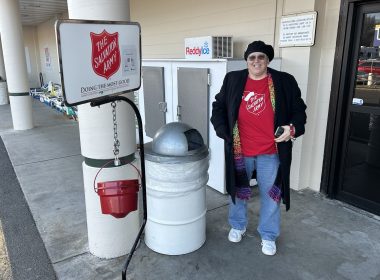The Salvation Army’s commitment to the armed forces
In the United States, the ministry of The Salvation Army to veterans has grown from serving coffee and doughnuts in World War I to providing numerous programs of support, comfort and cheer. The Salvation Army aims to honor and serve those who have made personal sacrifices to serve their country.
In fact, The Salvation Army’s participation in World War I (WWI) earned the respect of the U.S. population, capturing its imagination and changing its perception of the organization as a fringe religion to one providing honorable, godly service.
Before World War I
The Salvation Army was not always “America’s favorite charity.” According to one source: “Early in the 20th century, The Salvation Army was scorned by the public because of their seemingly bizarre methods. Open air meetings were out of the ordinary, and the use of military terms and marching down the street on parade to the beat of the drum were a far cry from the dignity and reserve of the established churches (Mildred Mendell, editor, The Doughnut Sweethearts).
World War I and The Salvation Army’s contribution to the conflict would change that attitude.
The U. S. enters WWI
When President Woodrow Wilson declared war against Germany on April 17, 1917, Americans were psychologically unprepared to participate in the “war to end wars.” Evangeline Booth (USA National Commander 1904-1934) summoned a Salvation Army National War Council and created a National War Board to meet the needs of American soldiers. She appointed national, territorial, and provincial war secretaries so that the entire Salvation Army was placed on a war-service basis.
American boys
The Salvation Army established service centers adjacent to U.S. military camps. But Evangeline wanted to do more than serve military in the U.S. “American boys are going to France,” she said. “We must go with them.”
She requested a meeting with General John J. Pershing, who would never forget The Salvation Army’s concern after a personal tragedy: In 1915, when he was a colonel, a fire destroyed his San Francisco home, killing his wife and three young daughters. Although other pastors largely ignored Pershing as a transient in the community, The Salvation Army reached out to him and his remaining family.
In their meeting, Pershing told Booth that while he appreciated her offer for expanded service, the U.S. already had an army over there. Soon, however, reports from the field indicated that demoralized American boys were deserting or turning to the vices available wherever soldiers are present.
Given a tentative “go-ahead,” Commander Booth sprang into action, sending Lt. Colonel William Barker overseas to determine what was needed.
He wired back a surprising response: “Send lassies!”
Salvation Army “lassies”
Booth had been busy securing the necessary funds to finance The Salvation Army’s war efforts. Showing her confidence in Barker, she included some carefully selected women officers in the groups sent to France. The work of the “Sallies” justified Barker’s wisdom in making the request.
The first group of Salvation Army officers left for France in August 1917; this group of 11 was from the Eastern Department. A second party of 11, mainly from the Western Department, sailed in September. From the outset, the number sent overseas was limited—they were carefully screened to ensure their integrity and commitment. Determined to send only the very best, Evangeline stated: I felt it was better to fall short in quantity than to run the risk of falling short in quality. Quality is its own multiplication table. Quality without quantity will spread, whereas quantity will shrink.”
Not one hint of scandal was ever associated with a Salvation Army lassie in France, although in nearly all cases the girls were subject to a constant adoration from thousands of homesick boys that might have turned their heads.
The first “hutment”
The Salvation Army began work on their first hut in France in September 1917. The staff of five men and six women—all musicians—gave concerts and held services and Bible classes along with operating the canteen. They also made the building available to other denominations or fraternal orders. Jewish services were held there, and the Loyal Order of Moose conducted an initiation there. The women officers provided a clothes-mending service.
Over the next 15 months, the huts multiplied to over 400. The tiny group of Salvationists and co-workers set up huts, hostels and rest rooms, all as nearly like home as human ingenuity could make them, some right at the front lines.
The famous doughnut
Of course, the doughnut became the symbol of The Salvation Army in France, but the lassies also baked pies and cakes in crude ovens and served lemonade to the troops. Not just the food, but also the spirit with which it was served captivated the men. The Salvationists served not only the soldiers, but also God, and they brought to mind thoughts of home and of the people there. At The Salvation Army hut the men could not only bring their uniforms to be mended; they could also bring their problems to share. As buttons were sewed on, they offered a message of help.
The front lines
One of the things the soldiers marveled at was that The Salvation Army followed them right to the front. The women as well as the men went to where the troops happened to be, and were often in danger from shells and gas.
Enthusiasm for The Salvation Army spread like wildfire through the forces in France, from the lowliest doughboy to General Pershing himself. Stories of the Army soon reached the U.S. and glowing reports of their service appeared in newspapers and magazines.











